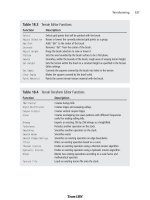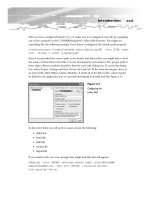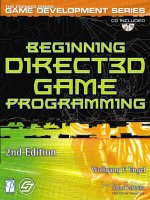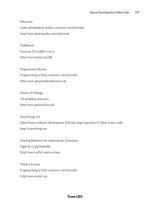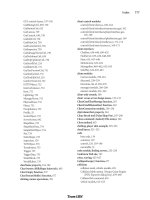3D Game Engine Design
Bạn đang xem bản rút gọn của tài liệu. Xem và tải ngay bản đầy đủ của tài liệu tại đây (1.41 MB, 50 trang )
3D Game Engine Design
for Mobile Phones
with OpenGL ES 2.0
M I K A E L G U S T A V S S O N
Master of Science Thesis
Stockholm, Sweden
2008
3D Game Engine Design
for Mobile Phones
with OpenGL ES 2.0
M I K A E L G U S T A V S S O N
Master’s Thesis in Computer Science (
30 ECTS
credits)
at the School of Computer Science and Engineering
Royal Institute of Technology year
2008
Supervisor at CSC was Henrik Eriksson
Examiner was Lars Kjelldahl
TRITA-CSC-E
2008:024
ISRN-KTH/CSC/E--
08
/
024
--SE
ISSN-
1653-5715
Royal Institute of Technology
School of Computer Science and Communication
KTH CSC
SE-
100 44
Stockholm, Sweden
URL: www.csc.kth.se
3D Game Engine Design for Mobile
Phones with OpenGL ES 2.0
Abstract
This master's project investigated the capabilities of mobile
phones to support 3D graphics for games and how to develop
for these devices using the OpenGL ES graphics library. A
simple 3D game engine was developed that runs on a PC using a
OpenGL ES 2.0 emulator library. Additionally, a game prototype
was developed using this engine. The report investigates the
differences between PC and mobile games, and how the mobile
platform affects the design of a 3D game engine. Furthermore,
the differences between OpenGL ES 1.1 and 2.0 are described,
covering the implications of developing game graphics with
shader programs. In conclusion, mobile phones supporting
OpenGL ES 2.0 will be available in 2008 and they will probably
support 3D graphics approaching the quality of recent PC
games. Developing games for these devices would be very
similar to developing PC games. The largest differences relating
to graphics are the screen size and memory constraints.
Utformning av 3D-spelmotorer för
mobiltelefoner med OpenGL ES 2.0
Sammanfattning
Det här examensarbetet hade som mål att utreda möjligheterna
för mobiltelefoner att stödja 3D-grafik för spel och hur
utveckling för denna plattform kan ske med hjälp av grafik-
biblioteket OpenGL ES. En enkel 3D-spelmotor utvecklades
genom att använda ett emulatorbibliotek för OpenGL ES 2.0 på
PC. Med hjälp av denna motor utvecklades en spelprototyp.
Denna rapport undersöker skillnaderna mellan mobil- och PC-
spel, samt hur den mobila plattformen påverkar utformningen av
en 3D-spelmotor. Dessutom så beskrivs skillnaderna mellan
OpenGL ES 1.1 och 2.0, och hur utvecklandet av spelgrafik
påverkas av shader-program. Slutsatsen är att mobiltelefoner
som stöder OpenGL ES 2.0 kommer att finnas tillgängliga under
2008 och att de troligtvis kommer att stödja 3D-grafik vars
kvalitet närmar sig moderna PC-spel. Att utveckla spel för sådan
hårdvara kommer i stora drag vara likvärdigt med att utveckla
PC-spel. De största skillnaderna ur ett grafikperspektiv är
skärmstorlek och minnesbegränsningar.
Table of Contents
1 Introduction 1
1.1 Problem Statement..............................................................................................1
1.2 Delimitations.......................................................................................................1
1.3 Thesis Outline.....................................................................................................2
2 3D Game Engine Overview 3
2.1 Resource Handling..............................................................................................3
2.1.1 Models.....................................................................................................3
2.1.2 Textures...................................................................................................4
2.1.3 Shaders....................................................................................................5
2.1.4 Materials..................................................................................................6
2.1.5 Animations..............................................................................................6
2.2 Scenegraphs........................................................................................................6
2.3 Rendering............................................................................................................7
2.3.1 Methods...................................................................................................8
2.3.2 View Frustum Culling.............................................................................9
2.3.3 Occlusion Culling..................................................................................10
2.3.4 Spatial Acceleration Structures.............................................................11
2.3.5 Hardware Specific Optimisations.........................................................12
3 Graphics Libraries 13
3.1 OpenGL ............................................................................................................13
3.1.1 Versions 1.0 – 1.5..................................................................................13
3.1.2 Versions 2.0 – 2.1..................................................................................15
3.2 OpenGL ES.......................................................................................................15
3.2.1 Versions 1.0 – 1.1..................................................................................16
3.2.2 Version 2.0.............................................................................................16
4 Graphics Hardware 18
4.1 PC Hardware.....................................................................................................18
4.2 Mobile Hardware..............................................................................................18
5 Approach 21
5.1 3D Game Engine...............................................................................................21
5.1.1 The Effect Files.....................................................................................21
5.1.2 The Model Files....................................................................................23
5.1.3 Scene Representation............................................................................24
5.1.4 Scene Management...............................................................................25
5.1.5 Animations............................................................................................25
5.1.6 Built-in and Custom Uniforms..............................................................26
5.1.7 Scene Rendering....................................................................................28
5.2 The Demon Demo.............................................................................................29
5.2.1 OpenGL ES 1.1 Adaptation...................................................................30
5.2.2 Symbian OS Adaptation........................................................................31
5.3 3D Kodo Game Prototype.................................................................................31
6 Evaluation 34
6.1 3D Game Engine...............................................................................................34
6.1.1 Resource Handling................................................................................34
6.1.2 Data Files..............................................................................................35
6.1.3 Scene Management...............................................................................36
6.1.4 Rendering..............................................................................................37
6.2 Demon Demo....................................................................................................37
6.3 3D Kodo Game Prototype.................................................................................38
7 Conclusions and Further Work 40
Chapter 1 - Introduction
1 Introduction
Mobile phones constitute an interesting hardware platform for game developers since so
many people always carry a phone around with them. However, mobile phones are
generally not specifically designed to support gaming, which poses problems for game
developers. One of these problems has been that mobile phones traditionally have
provided comparatively simple graphics. This thesis aims to evaluate the graphics
capabilities of current and upcoming mobile phones, specifically focused on 3D
graphics using the OpenGL ES graphics programming interface. OpenGL ES is an
adaptation of the OpenGL industry standard aimed at embedded systems, and is
available in two main versions: 1.1 and 2.0. This thesis is mainly focused on the later
version which supports more advanced graphical effects through the use of shader
programs.
The goals for the project were to examine how to develop mobile games with OpenGL
ES 2.0 and how three-dimensional graphics and shader effects can successfully be used
in mobile games. This was accomplished by developing a 3D game engine on top of a
OpenGL ES 2.0 emulator library currently available and using this engine to create a
game prototype. The differences between PCs and mobile phones, between 2D and 3D
games, and between 3D graphics with and without shaders were evaluated.
1.1 Problem Statement
My main research question for the thesis was:
What are the specific technical considerations relating to graphics that apply when
developing 3D games for mobile phones?
This thesis is specifically focused on graphics, and does not cover other areas such as
game design, sound or input. Furthermore, since most games are built on top of a game
engine and game engines handle the technical details of the platform, this thesis puts
much focus on the design of game engines for mobile phones.
1.2 Delimitations
Since the project was a collaboration between two students, Erik Olsson and Mikael
Gustavsson, the background information in chapters 2 – 4 are common to both reports.
The remainder of the theses are individual. We made the following delimitations
regarding the individual parts of the theses:
Mikael will focus on the construction of a 3D graphics engine based on the OpenGL ES
2.0 graphics library.
Erik will focus on evaluating the limitations of the platform from the experiences gained
while creating the game prototype.
1
Chapter 1 - Introduction
1.3 Thesis Outline
The thesis can be divided into two main parts; background and implementation/
evaluation.
Background provides some background information about graphics libraries, 3D game
engines and 3D graphics hardware in general and is referred to from other parts of the
thesis. The background part contains the following chapters:
3D Game Engine Overview
This chapter describes 3D game engines in general, as well as the different parts they
are commonly constructed of.
Graphics Libraries
This chapter describes the OpenGL and OpenGL ES graphic libraries, including an
overview of the version histories.
Graphics Hardware
A description of the development of graphics hardware, both for mobile phones and PC
for comparison.
Implementation/evaluation describes the details of our implementation of the engine and
game prototype, as well as an evaluation of the results. The chapters of this part is as
follows:
Approach
Implementation details, focusing on the 3D graphics engine.
Evaluation
An evaluation of our results as well as some more general discussion about 3D graphics
and games for mobile phones and how the limitations of the hardware affect the design
of game engines for mobile platforms.
Conclusions and Further Work
Conclusions of our work and suggestions for further study.
2
Chapter 2 - 3D Game Engine Overview
2 3D Game Engine Overview
A 3D Game Engine is a software component which is intended to perform certain tasks,
such as handling resources, scenegraphs and rendering.
2.1 Resource Handling
Resources are the content of the scene, i.e. what eventually is drawn on the screen.
Resources may include models, textures, shaders, materials and animations.
2.1.1 Models
Models are the geometries of the scene, which are bound to objects in the scenegraph.
Models can be generated through code, but most often they are read from a file, which
usually has been exported from a modelling application, such as Autodesk's Maya. The
geometry consists of vertex data, as well as a surface description which describes how
vertices are connected to create primitives such as polygons, triangle strips, lines or
points. Figure below shows an example model.
Vertices have different types of attributes, one of which is position. Other common
attributes are normals, texture coordinates, colours, tangents, binormals, bone weights
and bone indices. A vertex normal defines the surface normal at a specific position and
is most often used for lighting calculations. Texture coordinates are used to map a
texture image onto the surface. Tangents and binormals, together with normals, form the
basis of tangent space, which is sometimes referred to as surface space. Tangent space
is used for bump map lighting calculations. Bone weights and bone indices can be used
to deform a geometry in a non-rigid way, such as bending an arm of a character. This is
called skinning, and is most often used in animation.
3
Figure 1: A model of the famous Utah Teapot, shown here in wireframe mode
Chapter 2 - 3D Game Engine Overview
2.1.2 Textures
Originally, textures were two-dimensional images which were mapped onto surfaces.
Nowadays they are better thought of as general containers of data to be used during
rendering. Textures can be one-, two- or three-dimensional. When data is read from a
texture it is usually filtered to make the output continuous and reduce aliasing.
Textures can be used for a number of different purposes, for example:
● Diffuse map – defines the colour of the surface, i.e. the original use of textures.
By far the most common. See figure 2 above.
● Detail map – adds more fine-grained details than a diffuse texture and is usually
repeated across the surface with a high frequency.
● Specular map – defines the reflectiveness of the surface. Usually monochrome.
● Emissive map – defines the light emittance of the surface, which enables the
surface to glow regardless of external light sources.
● Ambient occlusion map – defines the accessibility of the surface and has to be
calculated with regards to the surrounding geometry. Points surrounded by a
large amount of geometry has low accessibility and becomes dark.
● Normal map – stores surface normals, which can be used in bump mapping to
give the illusion of a much more detailed geometry than what is actually used.
● Light map – stores a pre-calculated lighting of the scene. This technique is on
the decline due to the increasing dynamic nature of game worlds.
● Depth map – stores the depth of a scene as seen from some view. Often rendered
from a light position to be used in shadow calculations.
4
Figure 2: A textured Utah Teapot
Chapter 2 - 3D Game Engine Overview
● Environment map – stores a view of the environment as seen from an object or
the origin of the scene, either in the form of a sphere map (for instance a
photograph taken with a fish-eye lens) or as a cube map (a set of 6 images, one
for each direction along the coordinate axes). Environment maps are usually
mapped on objects to make them appear reflective.
Generally, hardware limits how many textures that can be used simultaneously when
rendering in real time. Textures can have a number of different channels, grey-scale
textures, also known as luminance textures, only have one channel, while colour
textures most often has four; red, green, blue and alpha (RGBA).
2.1.3 Shaders
Shaders are short programs that are usually executed on a graphics processing unit
(GPU). They combine the power of dedicated hardware with the versatility of a
software renderer. Different shader units are arranged in a pipeline, a typical example
can be seen in figure 3. Shaders receive data in the form of attributes and uniforms.
Attributes vary with every element that is processed and are provided either from the
previous shader in the pipeline or by the engine. Common attributes are described in
chapter 2.1.1. Uniforms on the other hand vary at most once per draw call. Typical
examples of uniforms are object properties such as position, texture bindings and
material properties. On modern hardware there are up to three types of shader units
available: vertex shaders, geometry shaders and fragment shaders.
Vertex shaders operate on individual vertices, and receive vertex attributes from the
engine. The vertex shader can generate or modify any vertex attributes, such as
position, colour or texture coordinates. Common usages include making a tree's
branches sway in the wind, moving raindrops and skinning a character model.
Geometry shaders operate on individual primitives, such as polygons, points or lines
and receive input from a vertex shader. The geometry shader can emit zero or more
primitives. Common usages include geometry tessellating, generating particle polygons
from points or extruding shadow volumes.
Fragment shaders, sometimes referred to as pixel shaders, operate on individual
fragments. The ouput of the fragment shader is the colour of a pixel written to the frame
buffer. The fragment shader also has the ability to discard a fragment so that it is not
written to the frame buffer. Common usages include per pixel lighting, bump mapping
and reflections.
When shader hardware is not available, a fixed function pipeline must be used. This
pipeline can usually be set up to perform basic calculations such as per vertex lighting,
rigid transformations and blending of several textures. Many effects can be
accomplished both with and without shaders, but shaders provide a much wider range of
effects and better image quality.
5
Figure 3: A shader pipeline
Chapter 2 - 3D Game Engine Overview
2.1.4 Materials
A material is basically a collection of textures, shaders and uniform values. Materials
are often exported from modelling applications or from shader studio applications such
as NVIDIA's FX Composer or AMD's RenderMonkey. These applications however
create and modify what they refer to as effects. Effects are best thought of as material
templates; for example, a fur effect might be used in several fur materials with different
colours or textures.
2.1.5 Animations
Animations can be divided into three groups, node animations, blend shapes and bone
animations, and span a certain number of frames. Animation data is specified either for
each frame, or at a number of keyframes. When a keyframed animation is played back,
data of two adjacent keyframes are interpolated to produce data for the frames in-
between in order to keep the animation fluent.
Node animations modifies the position, rotation or scale of nodes in the scenegraph.
Less commonly used in games, where it is primarily adopted for cut scenes and camera
movements.
Blend shapes are a sequence of models, which define the positions of the object's
vertices. Require much memory but little processing power, and were often used to
animate characters in older games.
Bone animations modifies the position, rotation or scale of certain nodes known as
bones. Vertices in a model are linked to one or many of these bones in order to follow
their movement. This technique is known as skinning. Bones are usually linked in a
hierarchical manner to affect each other, mimicking the behaviour of, for example, a
skeleton.
2.2 Scenegraphs
A scenegraph is a data structure that arranges the logical and often spatial representation
of a graphical scene [1]. A scenegraph contains a number of linked nodes, usually in
such a way that a node can have multiple child nodes, but only one parent, thus making
it a directed graph, see figure 4 for a simple example scenegraph. In order to be useful,
the graph should also be acyclic. Nodes can be divided into two categories, group
nodes, which may have children, and leaf nodes, which may not. There can be
numerous types of nodes, for instance transform nodes, object/model nodes, light nodes,
camera nodes and emitter nodes for particle systems.
6
Chapter 2 - 3D Game Engine Overview
A transform node is a group node which represents a transform relative to its parent
node. This arranges the scene in a hierarchical structure, which is useful for numerous
reasons, such as moving a complex object by only moving the parent node.
An object node, or a model node, is a leaf node that represents a graphical object that
can be rendered. It has references to a mesh and a material resource.
All leaf nodes, such as those for objects, lights, cameras and emitters receive transforms
from a parent transform node.
Scenegraphs are built and modified as the game world changes, but parts are often
loaded from files that have been exported from a modelling application or a custom
world editor.
2.3 Rendering
In 1986, Jim Kajiya introduced the rendering equation [3], which is a general integral
equation for the lighting of any surface.
L
o
x ,
= L
e
x ,
∫
f
r
x ,
' ,
L
i
x ,
'
'⋅
n d
'
The equation describes the outgoing light (L
o
) in any direction from any position on a
surface, which is the sum of the emitted light (L
e
) and the reflected light. The reflected
light itself is the sum of the incoming light (L
i
) from all directions, multiplied by the
surface reflection and cosine of the incident angle. All methods of calculating lighting in
modern computer graphics can be seen as approximations of this equation.
There are several ways of rendering a scene, such as ray-tracing and radiosity. Such
methods allow for advanced lighting effects and global illumination [4]. Global
illumination takes the environment into consideration so that effects such as reflections,
refractions and light bleeding are possible. However, global illumination is generally
7
Figure 4: A simple scenegraph of a car [2]
Chapter 2 - 3D Game Engine Overview
considered too slow to be applied to games. This section will hence focus on using
hardware accelerated rasterisation [4], which is the most common method employed by
games. Although rasterisation only directly supports local lighting effects, which only
considers the actual surface and light sources, modern games include many global
effects such as shadows and reflections. This, however, makes the process of rendering
a modern game a very complex task.
2.3.1 Methods
Drawing relies on the use of a depth buffer, also called z-buffer, which is a buffer that
associates a depth value with each pixel in the frame buffer [1],[4]. This allows the
drawing of objects to be performed in any order, since a pixel is written to the frame
buffer only if it is closer to the viewpoint than what is currently stored in the depth
buffer. This is called hidden surface removal.
The basic way of rendering a scene is as follows:
1. Traverse the scene graph in a depth-first-order, concatenating node transforms
with the resulting parent transform.
2. When an object node is reached, draw the object using its associated material
and model.
This approach unfortunately has several problems, some of which being that it cannot
render dynamic lights, dynamic shadows or transparent objects correctly. To handle
dynamic lights, the light node transforms have to be known before any objects are
drawn. Dynamic shadows are even more problematic since they require the use of
several rendering passes. Due to the nature of the depth buffer on current graphics
hardware, transparent objects has to be sorted back-to-front and drawn after the opaque
objects. The following method is an example of how to address these problems:
1. Traverse the scene graph and concatenate the node transforms, put the lights and
their transforms in a list, and put all objects and their transforms in another list.
2. For each light that casts shadows, render the scene as seen from the light source
to one or several depth maps.
3. Sort the list of objects, so that transparent objects are sorted back-to-front and
placed after opaque objects.
4. Draw the objects, using information from the list of lights and the light's depth
maps for lighting and shadow calculations.
There are several alternatives to this method, mainly related to lighting and shadows.
There are two common methods of drawing dynamic shadows in games, shadow
mapping and shadow volumes [4]. Shadow mapping uses the depth maps generated in
step 2, shadow volumes do not.
While the method listed above calculates lighting per-object-per-light (POPL); the
alternative, per-light-per-object (PLPO), is also common. If this method is used, the
fourth step in the previous method is replaced with the following two steps:
4. Draw the objects lit by the ambient lighting in the scene.
5. For each light, draw the scene again lit by only this light, additively blending the
result into the frame buffer.
8
Chapter 2 - 3D Game Engine Overview
This method is compatible with both shadow mapping and shadow volumes, whereas
the previous method only supports shadow mapping. However, it also requires the scene
to be rendered once per light. A method that does not have this performance drawback is
deferred shading, first suggested in a paper from 1988 by Michael Deering et al. [5],
although the term “deferred” is never used in the paper. The method modifies PLPO as
such:
4. Draw the objects lit by the ambient lighting in the scene. At the same time, also
draw additional information of the fragments such as position, normal, and
material information to extra frame buffers, these are collectively called the g-
buffer.
5. For each light, draw a light geometry (spheres for point lights, cones for spot
lights) of a reasonable size (a reasonable size would be the distance at which the
light's contribution becomes negligible) to determine what parts (if any) of the
visible geometry in the current rendering that should be affected by this light.
These light geometries are drawn with a fragment shader that reads scene
information from the g-buffer, calculates the light contribution and additively
blends the result into the frame buffer.
Even though this method has been known for quite some time, it is still sparsely used in
games since hardware that can support it has only recently become generally available.
All of these methods have advantages and disadvantages, POPL only draws the scene
once but the shaders become very complex or numerous since both material
characteristics and multiple lights have to be handled in a single pass. PLPO is the exact
opposite, the shaders are simpler but the scene has to be drawn multiple times. Deferred
shading seems to solve this problem since it has simple shaders and only draws the
scene once. However, the g-buffer is only possible to implement on the latest hardware
and has high memory requirements.
2.3.2 View Frustum Culling
Game worlds are often large, potentially containing tens of thousands of objects. Since
only a part of the world is normally visible at any time, rendering can be optimised by
discarding geometry outside of the view frustum, this is called frustum culling [1]. Such
a frustum has the geometrical shape of a square pyramid delimited by a near and far
viewing plane, as shown in figure 5. On older hardware, when the number of polygons
in scenes were lower and rasterising was slower, culling was often done on a per
polygon basis. On modern hardware, where geometry is often stored in dedicated
graphics memory, culling is normally done per object.
9
Figure 5: No culling (left) and view frustum culling (right) [6]
Chapter 2 - 3D Game Engine Overview
To speed up the culling of objects, the actual mesh geometry is usually not used but an
enclosing bounding volume [7]. The most common object bounding volumes are
spheres, boxes aligned to the coordinate system axes (Axis Aligned Bounding Box, or
AABB) and boxes aligned to the object (Oriented Bounding Box, or OBB). Frustum
culling is also used when rendering depth maps to be used in shadow mapping. A notion
related to frustum culling is frustum clipping where polygons that straddle the frustum
planes are split so that parts outside the frustum are discarded. This is done by modern
hardware in the process of rasterisation and not something that engine programmers
normally have to be concerned with.
2.3.3 Occlusion Culling
While view frustum culling potentially greatly reduces the number of non-visible
objects that are drawn, it does not hinder the drawing of objects occluded by other
objects. A further optimisation would therefore be to cull even such objects (see figure
6). This is not to be confused with the hidden surface removal performed with the depth
buffer (although this can be seen as occlusion culling on a per-pixel-basis), as occlusion
culling only is an optimisation to discard objects that will not contribute to the resulting
image.
There are a number of methods of accomplishing this, worthy of mention are potentially
visible set, portal rendering and hardware occlusion queries.
Potentially visible set divides a scene into regions and pre-computes visibility between
them. This allows for quick indexing to obtain high quality visibility sets at runtime.
However, since it is a pre-computation, changes to the objects in the scene are not
possible.
Portal rendering divides a scene into sectors (rooms) and portals (doors), and computes
visibility of sectors at runtime by clipping them against portals [7]. This is naturally best
suited for small, indoor scenes, and will have little impact on large, outdoor scenes
where there are no clear portals.
Hardware occlusion queries are a way of asking the graphics hardware if any pixels
were drawn during the rendering of a particular object [8]. That way, it is possible to
simulate rendering of the bounding volume of an object to see if the object is currently
occluded (i.e. no pixels would be drawn), and if so, that object can safely be skipped.
10
Figure 6: View frustum culling and occlusion culling
combined [6]
Chapter 2 - 3D Game Engine Overview
This method works on dynamic scenes and without any pre-computation, but requires
modern hardware and causes some overhead due to the additional draw calls.
2.3.4 Spatial Acceleration Structures
View frustum culling and occlusion culling minimises the number of objects that are
drawn by the graphics hardware. However, culling all the objects in a large world
against the view frustum can put a significant burden on the CPU. This and other
problems can be alleviated by using a spatial acceleration structure, such as a bounding
volume hierarchy (BVH) which is easily integrated with a scenegraph. Two popular
BVHs are sphere trees [9] and aabb-trees [10]. This is realised by having every node in
the scenegraph store a bounding volume, which encloses all objects in the subtree
rooted in the corresponding node. This makes many spatial queries, such as frustum
culling, much faster since an entire subtree can be tested without having to test every
individual object. However, this technique also has some computational overhead since
a subtree of the volume hierarchy has to be updated every time a node in the subtree
changes.
Bounding volume hierarchies are simple and can handle dynamic updates fast, but the
large amounts of static geometry common in games can be difficult to organise in a
hierarchy. Spatial partitioning structures are often used to remedy this problem. Such
structures are generally computationally expensive to construct and alter, but allow for
very fast handling of spatial queries. Common examples are quadtrees, octrees
(see figure 7 above), kd-trees and BSP trees [4]. These structures can be kept separate
from the scene graph, or be embedded in the scene graph. Some games use both
bounding volume hierarchies and spatial partitioning trees, while others store all data in
either.
11
Figure 7: Octree spatial acceleration structure
constructed around two spheres [11]
Chapter 2 - 3D Game Engine Overview
2.3.5 Hardware Specific Optimisations
Achieving high rendering performance with hardware accelerated graphics can be
difficult and require good knowledge of hardware and large amounts of testing. Some
general principles that can be addressed by a 3D game engine can however be
identified: minimise state changes, minimise draw calls and minimise stalls.
Minimising state changes can be done by carefully ordering how objects are drawn.
This can be done by sorting objects with consideration to their materials, shaders,
textures or geometry. State then only need to be changed when necessary as opposed to
fully resetting and setting all state for every object that is to be drawn. In less dynamic
games with a small number of objects running on simple hardware, this sorting can be
done as a pre-computation. Otherwise, sorting can be done every frame on the objects
currently in view (after any frustum and occlusion culling). One problem is transparent
objects since they need to be drawn after opaque objects and preferably in strict back-to-
front order, this makes minimising state changes difficult and is one reason to cut back
on the number of transparent objects. Other possible ways of minimising state changes
are to use fewer (and perhaps more complex) shaders, fewer textures (possibly
packaging several textures into texture atlases) or merging geometry data into fewer and
larger buffers.
Minimising draw calls is related to minimising state changes. Since a state change can
occur between draw calls only, fewer state changes need fewer draw calls. Minimising
draw calls is then done by merging objects that use the same state. This sometimes adds
considerable complexity, one example is particle systems. The simplest approach is to
draw each particle individually since all particles move independently each frame. In
practice, this is much too slow and particles should be batched so that even a particle
system consisting of thousands of particles is drawn with at most a few draw calls.
Minimising stalls means that the time that the graphics hardware is idle should be
minimised. Drawing commands issued from the CPU to the GPU are queued and
executed in the graphics pipeline (see figures 9 and 10); for optimal utilisation of
hardware resources, this queue should never be empty. To address this, care should be
taken to schedule CPU computations to occur when the drawing queue is filled. For
optimal performance in complex games, multi-threading will probably have to be used.
However, even if the CPU to GPU queue is not left empty, internal hardware stalls can
still occur due to the pipeline architecture of the hardware. This can happen for two
reasons: if a command needs the results of a yet uncompleted command further down
the pipeline or if a command requires state changes which are incompatible with
commands currently being processed further down in the pipeline. The first scenario can
happen if for instance the drawing of an object needs the content of a texture which is
currently being written to. The second scenario happens when some state such as blend
settings or the active shader need to be changed, this might not be possible to do without
waiting for all previous drawing commands to finish. The problem of internal stalls can
be addressed by reordering commands so that a command does not need the result of a
recent command or tries to update state which is likely to be currently used, minimising
state changes and draw calls also helps.
12
Chapter 3 - Graphics Libraries
3 Graphics Libraries
There has been many different programming libraries with the purpose of rasterising
images. Naturally, many custom solutions have existed within companies and
universities, but since hardware accelerated rasterisation became common graphics
programmers generally use the libraries provided by the hardware vendors. The two
most common libraries are called OpenGL and Microsoft's Direct3D. OpenGL is used
in a wider range of applications and is supported on more platforms. Direct3D is mostly
used for games, but is more popular than OpenGL in this area.
3.1 OpenGL
OpenGL (Open Graphics Library) is a standard specification defining a cross-platform
application programming interface (API) for rendering 2D and 3D computer graphics
[12]. OpenGL was originally developed by Silicon Graphics Inc. (SGI) but has since
1992 been governed by the Architecture Review Board (ARB) which consists of
representatives from many independent companies. Since 2006, ARB is part of the
Khronos group. OpenGL is widely used in Computer-Aided Design (CAD), scientific
visualisation, flight simulators and games.
OpenGL has an extension mechanism, this allows implementers of the library to add
extra functionality. Applications can query the availability of specific extensions at
runtime, making it possible for programs to adapt to different hardware. Extensions
allow programmers access to new hardware abilities without having to wait for the ARB
to incorporate it into the OpenGL standard. Furthermore, additions to the standard are
tested as extensions first to ensure their usability. This is important since all versions of
OpenGL are backward compatible, meaning that once a feature is accepted into the
standard it is never removed.
3.1.1 Versions 1.0 – 1.5
Version 1.0 of OpenGL was released in 1992 and it provides features such as per-vertex
lighting, texturing, fog and blending. Geometry is specified using the begin/end-
paradigm (see code listing 1) which is easy to use. OpenGL commands can be grouped
together and stored in display lists, which can then be executed repeatedly. This
improves rendering speed and allows calls to be organised in a hierarchical manner.
OpenGL supports several drawing primitives: points, lines, line strips, line loops,
triangles, triangle strips, triangle fans, quadrilaterals (quads), quad strips and polygons.
Supported vertex attributes are positions, colours, normals and texture coordinates.
Texture coordinates can also be automatically generated in order to save memory or
efficiently animate coordinates. OpenGL is often considered to be a state machine, since
it has a large number of global states which affect drawing. Examples of states are
13
Code listing 1: Drawing a triangle in OpenGL using begin/end-paradigm
glBegin(GL_TRIANGLES);
glColor3f(1, 0, 0); glVertex3f( 0, 1, 0);
glColor3f(0, 1, 0); glVertex3f(-1, 0, 0);
glColor3f(0, 0, 1); glVertex3f( 1, 0, 0);
glEnd();
Chapter 3 - Graphics Libraries
lighting settings, material settings, current texture, blending mode and matrix
transforms. Figure 8 shows how vertex positions in local object space (object
coordinates) are transformed into pixel positions in the framebuffer (window
coordinates). To learn more about coordinate transforms, there are several books
treating the subject, for example 3D Computer Graphics by Alan H. Watt [4].
The most important addition in OpenGL 1.1 was vertex arrays. Vertex arrays are an
alternative to the begin/end-paradigm and makes it possible to store vertex attributes in
arrays and draw directly from these. This greatly reduces the number of OpenGL
commands needed to draw geometry. The large number of commands of the begin/end-
paradigm began to be problematic as rendering hardware became faster and geometric
models became more detailed.
Version 1.2 of OpenGL was released in 1998 and added three-dimensional textures and
more blending modes among other features.
OpenGL 1.3 was released in 2001 and added several important features. Compressed
textures allow textures to be used while stored in a compressed form, reducing memory
consumption. Cube maps enable more detailed environment mapping effects.
Multitexturing and texture environment settings allow geometry to be mapped with
several textures simultaneously which can be combined in several different ways. This
allows for much more advanced surface details and can be seen as a primitive form of
shaders. For instance, a special combiner mode allows for bump mapping effects. Also,
support for fullscreen antialiasing was added.
In 2002 OpenGL 1.4 was released. It added support for depth maps and shadow
rendering with shadow mapping. Texture environment settings were made more
powerful and additional blending modes were added.
In the following year, OpenGL 1.5 was released and added two important features:
occlusion queries and vertex buffer objects (VBO). Vertex buffer objects allow vertex
arrays to be stored in dedicated graphics memory. This allows for significantly faster
rendering of complex geometry compared to normal vertex arrays. This problem had
already been addressed by display lists, but VBOs are simpler for library implementers
to optimise and they are better suited to handle dynamic geometry.
14
Figure 8: Vertex transformation sequence in OpenGL

